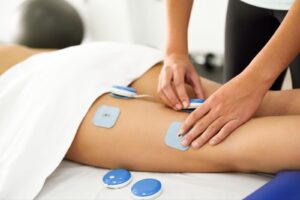Suffering from a torn meniscus might force you to take a break from your favorite activities, but it doesn’t necessarily mean the termination of your workout regimen. In this piece, we’ll lead you through a series of effective exercises and stretches aimed at fortifying the muscles that provide support to your knee, enhancing your flexibility, and aiding in your recovery journey, ultimately helping you regain your mobility.
Benefit-Rich Heel Slides for Torn Meniscus Recovery
Heel slides are an impactful lower-body exercise that aid in increasing knee joint mobility and strengthening the hamstrings, quadriceps, and glutes. Recommended for those recovering from a torn meniscus, proper execution of this exercise can expedite the healing process.
Here’s a step-by-step guide on how to perform the Heel Slides exercise:
Step 1: Start by positioning yourself on a flat surface, preferably a mat. Lay flat on your back in a relaxed state, maintaining straight alignment from head to toe.
Step 2: Keep one leg extended straight on the ground, and bend the other knee slowly. Gradually pull your heel towards your buttocks. An important factor to note is to maintain the bend in your knee throughout the movement to avoid straining the ligaments in the knee.
Step 3: Once you’ve drawn the heel as close to your buttocks as comfortably possible, hold for a moment to maximize the stretch.
Step 4: Carefully extend the bent leg, sliding the heel back down so both legs are flat on the ground again. It’s vital to maintain a slow and controlled motion to avoid any sudden jerks or extended pressure on the knee.
Step 5: Repeat this exercise ten times for one set.
Perform three sets in total during each exercise session, ensuring a rest of 1-2 minutes between each set. This allows the muscles to recover, preventing unnecessary strain.
Incorporating these exercises into your recovery plan can have notable benefits, such as reducing stiffness, improving flexibility, and promoting faster healing. However, always consult with a physiotherapist or doctor before starting any new exercise regimen. Your healthcare professional can provide guidance tailored to your specific condition and recovery progress. Also, learn the signs of athlete’s foot symptoms before they sideline you.
Effective Recovery with Hamstring Curls
Hamstring curls are an ideal exercise for recuperating from a torn meniscus. The aim is to gently activate the hamstring muscles while keeping the knee joint involved, promoting the necessary mobility and strength conducive to a quicker recovery.
Here’s an elaborate guide on how to execute this exercise:
Step 1: Position yourself on a flat, comfortable surface such as a mat or the carpeted floor. Lie face-down, ensuring your body alignment is straight from head to toe.
Step 2: Keeping one leg extended straight on the surface, carefully bend your other knee. Draw it slowly back up towards your buttocks as far as your comfort and mobility allow. This movement should isolate the hamstring, the back muscular part of your thigh.
Step 3: Gradually lower the bent knee back down, returning to the starting position with both legs straightened on the surface. The key is to exercise control and patience, avoiding any sudden or jerky movements that might cause discomfort.
Step 4: Repeat the same procedure with the other leg, ensuring an even workout on both sides.
Step 5: For one complete set, perform this exercise ten times for each leg.
For optimal results, execute a total of three sets, taking a break of 1-2 minutes between sets to allow for muscle rest and recovery.
Remember, consistency is crucial when recovering from a torn meniscus. Regularly performing exercises like hamstring curls can significantly enhance the healing process. It is always advisable to consult with a medical professional or physiotherapist before commencing any new exercise program. Always listen to your body, and adjust the exercises according to your comfort and progress levels.
Enhance Healing with Straight Leg Raises
The Straight Leg Raise is a highly effective exercise designed to strengthen the quadricep muscles without putting much pressure on the knee. This exercise, when executed correctly, can aid the recovery process of a torn meniscus by enhancing knee joint stability.
Here’s a detailed guide to perform this exercise:
Step 1: Start by positioning yourself on a flat surface, preferably a mat. Lay back flat, keeping your body aligned from head to toe.
Step 2: Maintain one of your legs completely straight on the ground. Slowly elevate the other leg straight up, aiming to reach at least a 45-degree angle from the ground. Be mindful not to elevate the leg too high to refrain from causing undue stress on the hip flexor and lower back.
Step 3: Lower the raised leg back to the resting position calmly and in a controlled manner.
Step 4: Repeat the same procedure with the other leg, ensuring an even workout on both sides.
Step 5: For one complete set, perform this exercise ten times on each leg.
Include a total of three sets in each exercise session, incorporating a rest period of 1-2 minutes between each set to allow for muscle relaxation and recovery.
The Straight Leg Raise should become a fundamental part of your recovery plan from a torn meniscus. Regularly performing these exercises can accelerate the healing process by strengthening the quadricep muscles, which support the knees. As always, it is advisable to consult with your healthcare professional before starting this or any new exercise regimen. Keep track of your progress, and adjust the exercises based on your comfort, mobility, and fitness level.
Recovery-Optimized Wall Squats
Wall squats, also known as wall sits, are a versatile lower body exercise that can aid the healing process of a torn meniscus. This exercise effectively engages the quadriceps, hamstrings, and hip muscles without causing significant strain on the knee joint, making it an ideal addition to your recovery regimen.
Here’s an in-depth guide on how to execute wall squats:
Step 1: Position yourself in standing pose with your shoulders and back comfortably leaned against a flat, upright surface, such as a wall. Ensure your feet are shoulder-width apart and placed approximately a foot (around 30 cm) away from the wall. This stance should resemble that of sitting on an invisible chair.
Step 2: Gradually bend your knees and lower your body down towards the floor. Ensure the motion is slow and controlled, preventing any sudden knee strain.
Step 3: Pause once you’ve achieved a posture similar to sitting on an imaginary chair, with your thighs approximately parallel to the ground. Maintain this position for about ten seconds. This hold engages and strengthens the muscles effectively.
Step 4: After holding, slowly push against the wall to slide your body back up to the initial standing position. Remember to engage your core and maintain a straight back throughout the entire exercise.
Step 5: Repeat this exercise ten times to complete a set.
Incorporate a total of three sets into your workout, ensuring a short resting period of 1-2 minutes between each set.
Wall Squats are excellent for strengthening the thigh and hip muscles, enhancing stability, and promoting faster recovery from a torn meniscus. As always, seek medical advice or a consultation from a physiotherapist before starting a new exercise routine. Be sure to listen to your body and adjust the exercise intensity as per your comfort and progress.
Encouraging Healing with Seated Knee Extension
The Seated Knee Extension, also known as the Leg Extension, is a valuable stretch for those recuperating from a torn meniscus. This exercise focuses on enhancing the flexibility of the knee joint and strengthening the quadriceps, facilitating faster recovery.

Here’s a comprehensive guide on how to perform this stretch:
Step 1: Begin by sitting on a chair or bench with your feet firmly planted on the ground. Maintain a straight back, and ensure your thighs are parallel to the ground.
Step 2: Gradually lift one leg, extending it out in front of you. The movement should be primarily initiated from the knee, keeping your thighs stationary.
Step 3: Hold the extended position for a few seconds, ensuring the quadriceps are engaged throughout.
Step 4: Carefully lower your leg back down, returning your foot to the ground.
Step 5: Repeat the exercise with the other leg, ensuring an even workout on both sides.
Step 6: Perform this exercise ten times on each leg to complete a set.
Perform three sets for an effective workout, taking a brief rest of 1-2 minutes between each set to allow your muscles to recover.
The Seated Knee Extension can be a significant addition to your torn meniscus recovery program. Incorporating this stretch can boost the flexibility and strength of your knee joint, promoting mobility and enhancing healing. As with any exercise, it is advisable to consult with your healthcare professional or a physiotherapy specialist before starting this routine. Always monitor your progress, and adjust the exercises based on your comfort, mobility, and fitness level.
Speeding Recovery with Calf Raises
Calf Raises are a simple yet productive healing exercise. Practicing calf raises can help to stabilize the knee joint, increase strength and flexibility in the calf muscles, and foster quicker recovery from a torn meniscus.
Follow this detailed instruction to carry out Calf Raises effectively:
Step 1: Start in a standing position, ideally near a wall or chair to provide support if needed. Your feet should be hip-width apart and flat on the floor.
Step 2: Begin the exercise by slowly lifting your heels off the ground, transferring your weight onto the balls of your feet. Aim to raise your heels as high as comfortably possible, engaging your calf muscles.
Step 3: Once you’ve reached the highest comfortable point, hold this position for a couple of seconds to maximize muscle engagement.
Step 4: Carefully lower your heels back down to the ground in a slow and controlled manner.
Step 5: Repeat the movement ten times — this makes one set.
Include three sets of this exercise in your routine, taking a rest of approximately 1-2 minutes between each set.
Regularly engaging in Calf Raises can significantly benefit healing from a torn meniscus by enhancing knee stability and fostering lower leg strength. As always, it is advised to consult with your doctor or physiotherapist before starting any new exercise routine. Listen to your body, adjust the intensity of the exercises based on your comfort, and steadily increase repetitions as your strength and flexibility improve.
Conclusion
Conclusively, a torn meniscus can cause considerable pain, yet through meticulous care and rehabilitation, one can restore knee functionality and achieve optimal strength and flexibility. The recommended exercises and stretches detailed within this discourse serve as invaluable aids throughout the recovery journey. It is imperative, however, to acknowledge that each individual’s healing process varies, underscoring the necessity to attune to one’s body and consult medical professionals when apprehensions arise.
Maintaining a steadfast commitment to consistency proves pivotal; engaging in exercises with regularity and diligence yields optimal outcomes. With unwavering dedication and patience, conquering a torn meniscus becomes attainable, enabling a return to cherished activities with renewed vigor.


